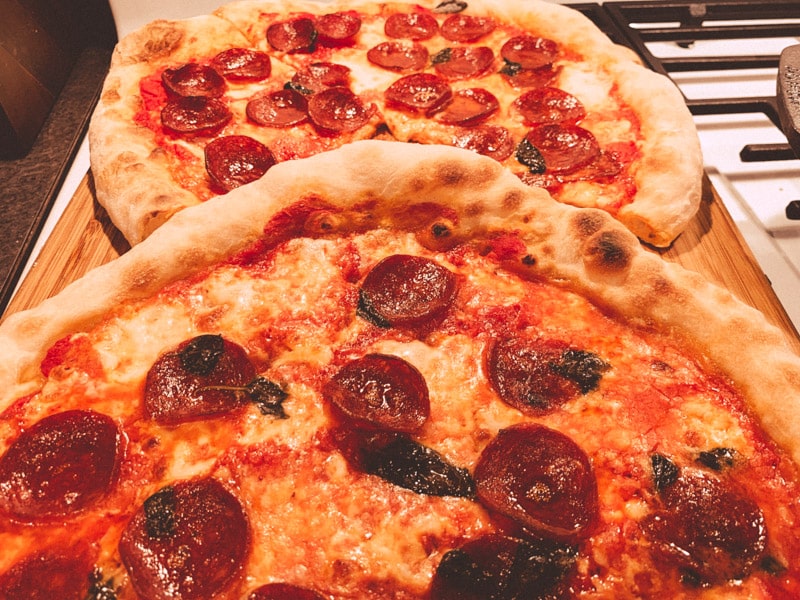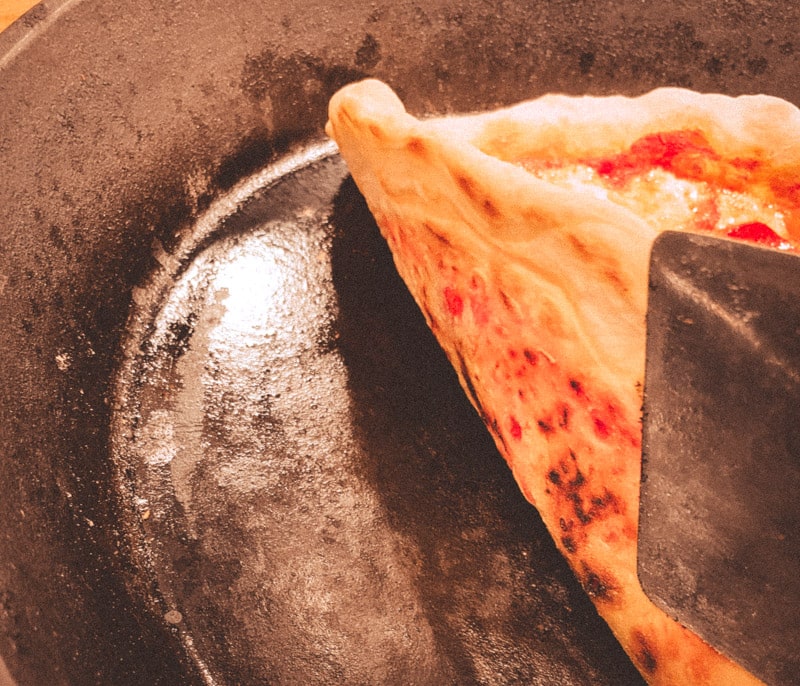Ratings, percentages, and more
rating: 9/8 slices

hydration: 68%

difficulty: moderate

Ingredient percents
| Ingredient | Standard % | Baker’s % |
| Flour (665g) | 58.65% | 100% |
| Salt (18g) | 1.59% | 2.71% |
| Yeast (0.78g) | 0.07% | 0.12% |
| Water (450g) | 39.69% | 67.67% |
Summary
- So much salt and so little yeast.
- Longest room temp rise I’ve tried.
- Delicate crust with just enough chew.
Watch the Video!
Great Neapolitan Pizza in a Home Oven

I can’t believe I made this pizza in my home oven. Before this recipe, I thought making anything close to my favorite local Neapolitan pizza place couldn’t be done in a home oven. Is this as good as Pupatella? Maybe not, but it’s good enough that I’d need a side-by-side comparison to choose a clear winner. (OK — I’m exaggerating a little, making true Neapolitan pizza that adheres to the AVPN’s regulations can’t be done in a home oven — more details on my Neapolitan pizza page.)
A Long Room Temp Rise Pays Dividends

What made this recipe a success? A few things standout, including the use of all 00 flour and folding the dough instead of kneading. But, I’d made recipes that relied on these techniques before, and while I’m sure they helped, there are two other aspects of this recipe that interest me even more. First, a minuscule amount of yeast combined with a fairly high amount of salt allow for the longest room temperature rise that I’ve ever done — I let it rise for 12 hours at room temperature. Many recipes call for that length of rise in the refrigerator, but this is the only one I’ve encountered that suggests a rise that long at room temp.* In addition to creating an amazing crust, one other advantage of this recipe is that it allows you to put the dough in the fridge for up to 5 days after the initial room temperature rise. At least, that’s what Lagerstrom says, I only put it in the fridge for 5 hours, so I can’t confirm.
*I first made this pizza fairly early in my Neapolitan journey. I've since discovered that a long room temp rise, with minimal yeast is not unusual for Neapolitan dough recipes.
My second key takeaway from this recipe was Lagerstrom’s stretching technique. I found the technique itself challenging, so I modified it and just held down one side of the dough, while stretching with as little disturbing of the crust as possible. And I think that last part — touching the outer crust as little as possible — is the key to getting that light, poofy outer edge of crust.
One more technique that I picked up from this recipe is wetting your hands before folding the dough instead of flouring or oiling them. While I don’t know that this is critical to the recipe’s success, it works surprisingly well, reduces mess, and keeps you from adding more flour or oil to the dough.
Making this Neapolitan Even More Notable with Modifications

I followed this recipe exactly up until the cooking stage. Lagerstrom uses an Ooni oven, which I don’t have. So when it came time to cook, I used Kenji Alt-Lopez’s technique, modified slightly, as detailed on my Top Neapolitan Pizzas page. The technique worked well with this dough.
Lagerstrom suggests making 4 pizzas from this recipe. Putting a large, thin and delicate, stretched dough into a hot cast iron skillet is challenging, especially because my pies were coming out around 14inch in diameter — basically the size of my pan. So, if you are using the cast iron skillet method, I recommend making smaller pizzas — maybe divide the dough into 6 (or even 8) portions, instead of 4 per the video.
Also, the dough is quite delicate and I had several tears as I moved the dough from the counter to the skillet. To lessen the chance, I recommend heavily flouring the surface, and, as mentioned above, smaller crusts. If you do get a tear, the dough is easy to pinch back together, although that’s something you want to be very careful with when doing it in a hot skillet.
And, make sure to regularly check and rotate the pizza when it’s under the broiler — you’d be surprised how fast it can burn. Also check the underside of the crust before you put it in the broiler to make sure it’s cooked enough. If it’s not, leave the pan on the stovetop and cook it a little more, but, again, check it often as it can burn quickly.
Finally, this pizza is notably better the first day, so enjoy it while it’s fresh!
Final Thought
A long-room temp rise is critical to enjoying this Neapolitan prize.
